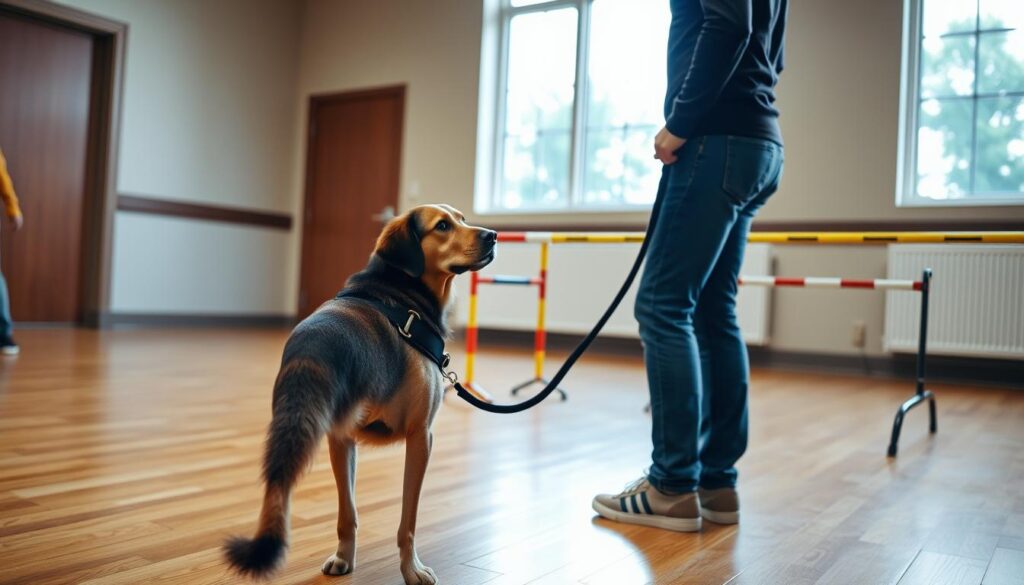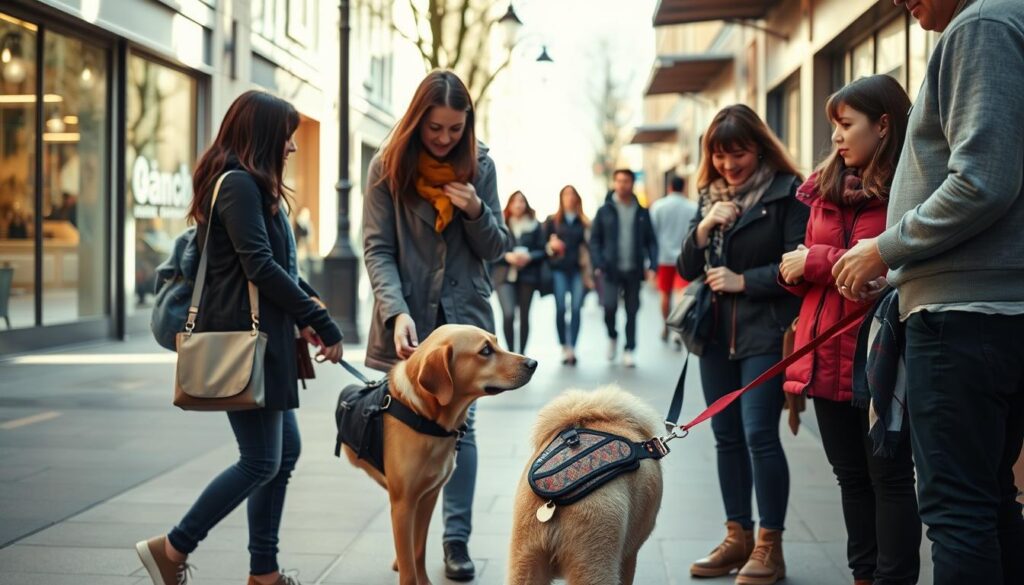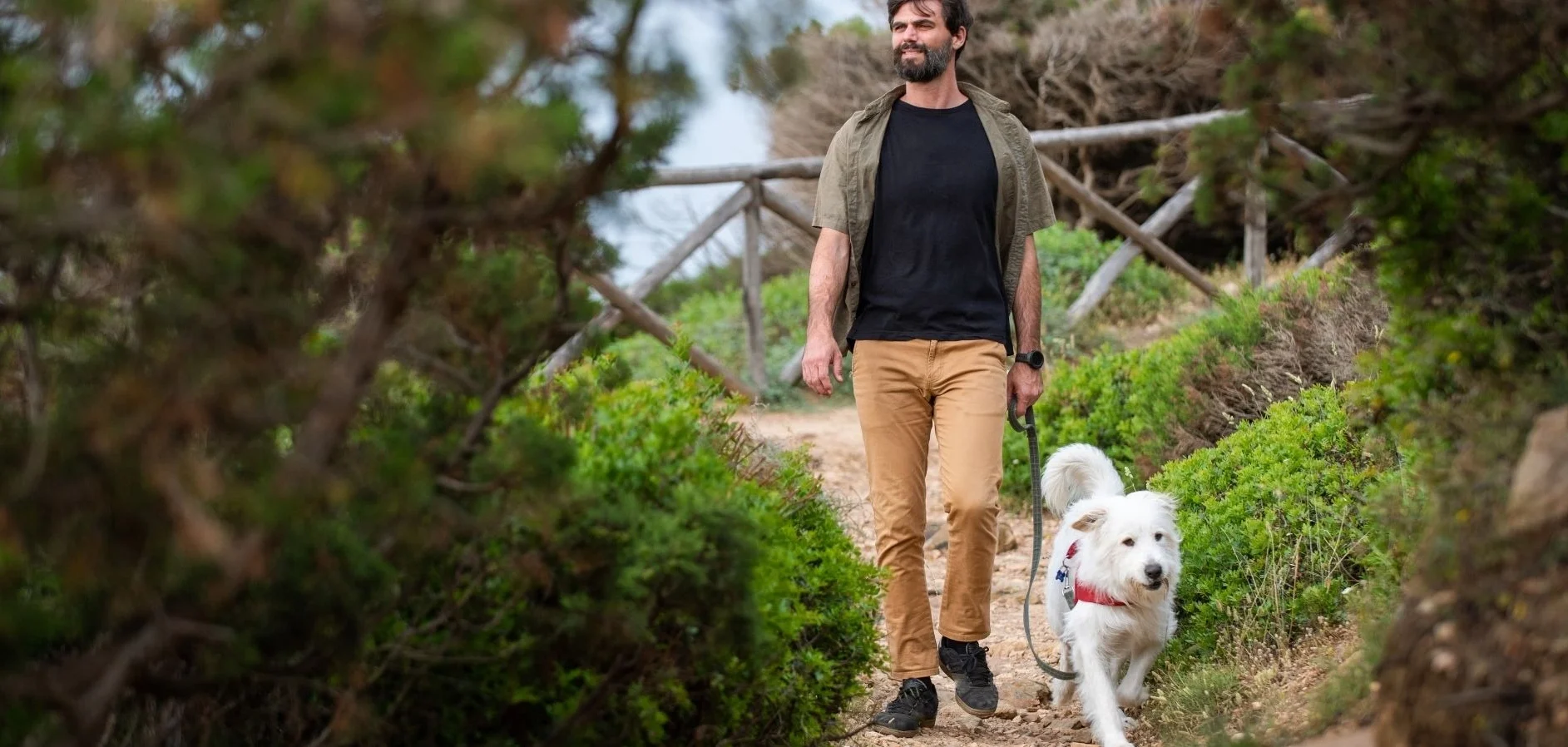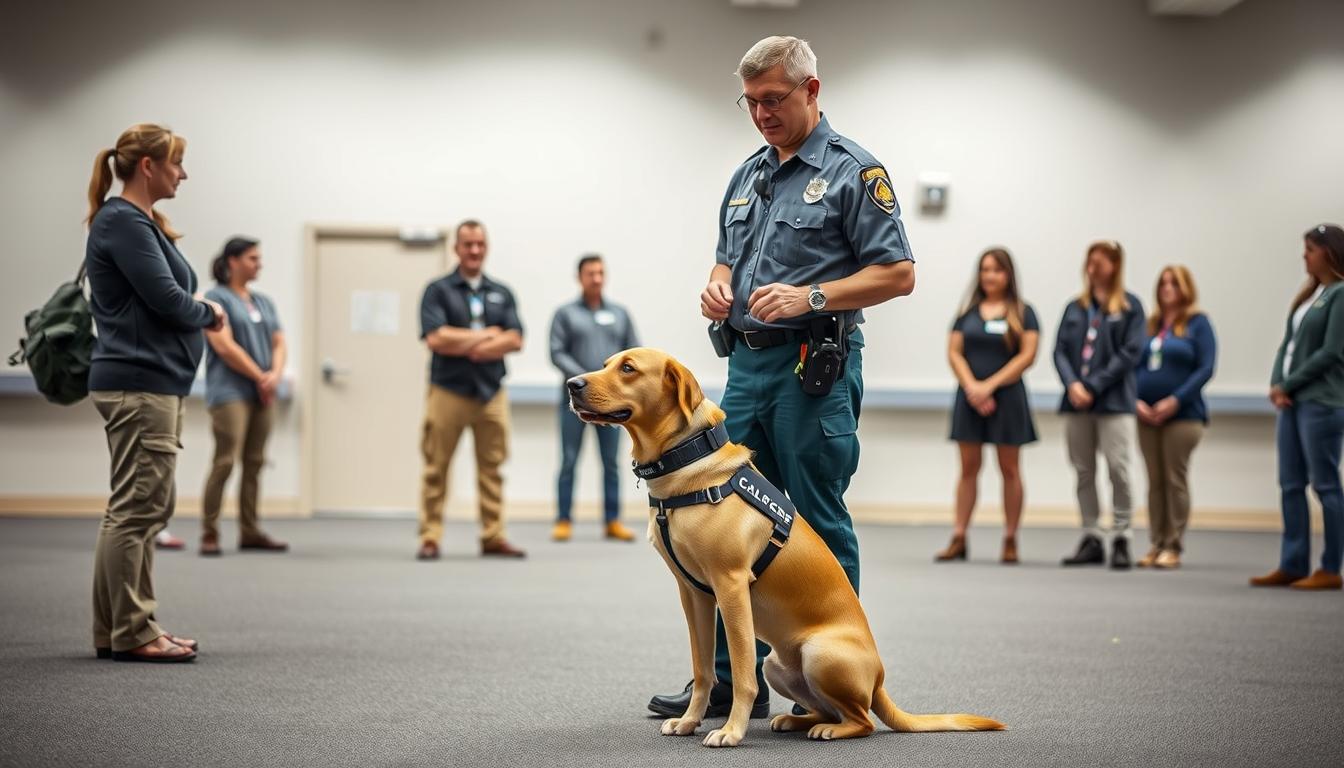How to Make My Dog a Service Dog: 5 Happy & Easy Steps
Table of Contents
How to Make My Dog a Service Dog
When I found out my loyal dog could be more, it was both scary and exciting. Living with a disability showed me service dogs are more than pets—they’re lifesavers. If you want to make your dog a service dog, you’re starting a journey that changes everything.
Training a service dog needs commitment, patience, and knowing your needs and your dog’s abilities. Not every dog can be a service animal. But, with the right training, many dogs can help a lot, making life better.
This guide will show you how to turn your dog into a certified service dog. We’ll cover everything from legal rules to special training methods. These can help your dog become a key support for you.
Key Takeaways
- Service dogs provide critical assistance for individuals with disabilities
- Not all dogs are suitable for service dog training
- Professional training is essential for certification
- Legal requirements must be carefully understood
- Service dogs require ongoing training and socialization
- Emotional bond between handler and dog is crucial
Understanding What a Service Dog Is
Service dogs are vital for people with disabilities. They offer special help that changes lives. These dogs are not just pets; they are trained to assist with daily challenges.
A service dog is trained to help with a person’s disability. They are not the same as emotional support animals or therapy dogs. Service dogs must meet strict training standards and follow laws.
Defining a Service Dog
The Americans with Disabilities Act (ADA) defines service dogs clearly. These dogs are trained to help people with physical, sensory, or mental disabilities. They are trained to do specific tasks.
Types of Service Dogs
- Guide Dogs: Assist individuals with visual impairments
- Hearing Dogs: Alert deaf or hard-of-hearing individuals to sounds
- Mobility Assistance Dogs: Help people with physical limitations
- Seizure Response Dogs: Provide support during medical emergencies
- Psychiatric Service Dogs: Support individuals with mental health conditions
Legal Rights of Service Dogs
Service dogs have legal rights under federal law. They can go with their handlers in places where pets can’t. This law helps people with disabilities live more easily.
| Service Dog Type | Primary Assistance | Specific Tasks |
|---|---|---|
| Guide Dogs | Visual Navigation | Navigating obstacles, street crossings |
| Hearing Dogs | Sound Alert | Detecting doorbells, alarms, phones |
| Mobility Dogs | Physical Support | Retrieving items, opening doors |
Learning about service dogs shows their great importance. They receive special training to help people with different needs.
Assessing Your Dog’s Qualifications
Figuring out if your dog can be a service dog needs careful thought. Not every dog is right for service work. But knowing the key requirements can help you decide if your dog fits the bill.
Choosing the right dog for service training means looking at several important factors. Your dog must show qualities that go beyond being a regular pet.
Breed Considerations
While no breed is automatically a service dog, some are better suited. The best service dog breeds usually have:
- High intelligence
- Strong work ethic
- Moderate to large size
- Calm temperament
- Ability to focus under distraction
Temperament Assessment
A service dog’s temperament is key. Your dog should have:
- Exceptional emotional stability
- Low reactivity to environmental stimuli
- Ability to remain calm in crowded spaces
- Quick recovery from unexpected situations
Health and Age Requirements
Your potential service dog must be in top shape. Vets say start training when your dog is 1-2 years old. This age ensures they’re physically mature and still learning well.
A healthy service dog is the foundation of effective disability assistance.
Experts recommend detailed health checks to see if your dog is ready for service work. Genetic tests and physical exams help figure out their long-term potential.
Training Your Dog for Service Tasks
Turning your dog into a reliable service dog takes time, effort, and structured training. It starts with basic skills and moves to specific tasks for different needs.
Training a service dog is more than just pet training. Your dog needs to be very obedient and do complex tasks well.
Basic Obedience Training Fundamentals
Before learning special tasks, your dog must know basic obedience:
- Sit and stay commands
- Walking calmly on a leash
- Responding to verbal and hand signals
- Maintaining focus in distracting environments
Specialized Training Techniques
Every service dog needs unique training for their tasks. These can be:
- Medical alert training
- Mobility assistance
- Psychiatric support
- Navigation assistance
“A well-trained service dog is not just a pet, but a lifeline for individuals with disabilities.” – Service Dog Training Institute
Finding a Professional Trainer
Professional trainers can help your dog learn faster. Look for these qualities in a trainer:
| Criteria | What to Look For |
|---|---|
| Certification | Recognized service dog training credentials |
| Experience | Proven track record with multiple service dog training programs |
| Specialization | Expertise in specific service dog tasks relevant to your needs |
| Training Approach | Positive reinforcement methods |
Remember, service dog training is an ongoing process. It needs constant practice and reinforcement.
The Certification Process for Service Dogs
Getting your service dog certified can be tricky. The Americans with Disabilities Act (ADA) doesn’t require it, but it helps a lot. It makes things easier for you and your dog.
Why Certification Matters
Service dog certification has many benefits:
- It makes you more credible in public places.
- It shows your dog’s training clearly.
- It makes talking to businesses easier.
- It gives you peace of mind.
How to Obtain Certification
To get certified, you need to:
- Undergo a thorough training check.
- Get your dog’s behavior assessed.
- Make sure your dog is healthy.
- Get papers from professional trainers.
Common Certification Organizations
Many trusted groups offer certification. When picking one, look for those focused on service dog training and papers.
Pro tip: Choose organizations that offer detailed training and checks that fit your needs.
Some well-known groups include:
- Assistance Dogs International
- International Association of Assistance Dog Partners
- Service Dogs of America
Even though it’s not required, getting certified helps a lot. It proves your dog’s training and skills.
Understanding ADA Regulations
Handling service dog laws can be tough. The Americans with Disabilities Act (ADA) helps a lot. It makes sure people with disabilities can go out with their service dogs.
Overview of Service Dog Protections
The ADA sets clear rules for service dogs. It says a service dog is an animal trained to help someone with a disability.
- Service dogs can go into most public places
- Businesses can’t ask for special papers
- There can’t be extra costs for service dogs
Rights and Responsibilities of Handlers
Service dog laws give a lot of protection. But handlers have to do their part too. Your service dog must be well-behaved and do its job.
| Handler Responsibility | ADA Requirement |
|---|---|
| Dog Behavior | Must be calm and not cause trouble |
| Public Access | Can go everywhere public is allowed |
| Task Performance | Must be trained for specific tasks |
Public Access Rights
Service dog laws let you take your dog into public places. Places like restaurants, stores, and hospitals can’t say no to a well-behaved service dog.
“A service dog is not just a pet, but a vital support system for individuals with disabilities.” – ADA Guidelines
Training Tasks Specific to Your Needs
Service dog training turns a dog into a vital support for people with disabilities. Learning to identify and develop the right tasks can greatly enhance your life.

Every disability is different, so service dog tasks must be tailored to each person’s needs. Your dog’s training will focus on the help you need most.
Identifying Your Specific Needs
Before starting service dog training, assess your daily challenges. Think about:
- Physical limitations you face
- Medical conditions you have
- Activities that need extra help
- Emergency situations you might face
Common Tasks Service Dogs Perform
Service dogs can do many important tasks, such as:
- Picking up dropped items
- Opening and closing doors
- Helping with mobility
- Alerting to health issues
- Guiding people who can’t see well
Customizing Training for Individual Tasks
Creating specific tasks for your service dog takes time and special training methods. Break down big tasks into smaller steps so your dog can do them well and often.
The secret to great service dog training is knowing your unique needs and working with skilled trainers. They help you reach your goals.
Professional trainers can create a training plan just for you. This ensures your service dog is a key partner in overcoming daily hurdles.
Socializing Your Service Dog
Service dog training is more than just basic obedience. Socialization is key to making your dog a great service animal. A well-socialized dog can handle complex places calmly and focus on helping their handler.
Learning to make your dog a service dog means understanding socialization’s importance. Your dog needs to be okay in many places, with different people, and with distractions.
Why Socialization Matters
Good socialization teaches your service dog important skills:
- Stay calm in crowded areas
- Ignore distractions
- React well to surprises
- Act professionally in public
Strategic Socialization Techniques
Here are ways to boost your service dog’s confidence:
- Begin with simple places
- Make social situations more complex slowly
- Use positive rewards
- Introduce your dog to different sounds, textures, and experiences
Exploring Different Environments
Take your service dog to various places like:
- Shopping centers
- Public transportation
- Busy sidewalks
- Restaurants and cafes
Be patient and keep training up. This will help your service dog be reliable and confident in any situation.
Dealing with Public Reactions

Going out with a service dog needs patience and clear talk. Laws protect your rights, but people’s understanding can differ a lot. It’s key to teach others politely and respectfully.
Understanding Common Misconceptions
Many people get service dogs wrong. Some big mistakes include:
- Thinking all service dogs wear special vests
- Believing service dogs can be petted anytime
- Assuming service dogs are just pets
Educating the Public About Service Dogs
Getting a service dog means you also have to teach others. Calm and clear talk helps people get your dog’s role.
- Be ready with a short, clear explanation of your dog’s job
- Carry cards that explain service dog rights
- Speak firmly but kindly when needed
Handling Disrespectful Responses
Some might question your service dog’s right to be there. Knowing the laws helps you stand up for your rights. Practice being professional:
- Stay calm and composed
- Clearly state your legal rights
- Share brief, factual info if it’s right
- Ask for help from management if needed
Remember, your service dog is a working pro who deserves respect and focus in public.
Maintaining Your Service Dog’s Skills
To keep your service dog at their best, you need to put in a lot of effort. Training them is a never-ending task. It requires constant care to make sure they stay effective and reliable.
There are key steps to keep your service dog’s skills sharp. These steps help keep their abilities top-notch and their health in check.
Regular Training Refreshers
Your service dog needs regular practice to stay sharp. Here are some tips to keep their training on track:
- Schedule weekly practice sessions for learned tasks
- Use positive reinforcement techniques
- Keep training sessions short and engaging
- Track progress and identify areas needing improvement
“Consistent training is the key to a reliable service dog” – Professional Service Dog Trainer
Continuous Socialization
Service dogs need more than just training. They also need to be socialized. This helps them stay calm and focused in different places:
- Expose your dog to different public spaces
- Practice interactions with strangers
- Navigate diverse sensory experiences
- Maintain calm behavior under various stimuli
Health Check-Ups
Regular vet visits are essential for your service dog’s health. Preventative health management ensures long-term effectiveness and well-being.
- Annual comprehensive health screenings
- Updated vaccinations
- Dental and physical fitness assessments
- Nutrition and weight monitoring
Transitioning to Life with a Service Dog
Getting a service dog is a big step in your journey. It needs careful planning and dedication. You must create a supportive home for your new friend to thrive.
Preparing your home for a service dog is important. You need to make a welcoming and functional space. This space should meet your needs and your dog’s work needs.
Creating a Comfortable Home Environment
- Designate a specific resting area for your service dog
- Remove potential hazards and breakable items
- Establish a clean and organized living space
- Prepare feeding and water stations
Establishing a Consistent Routine
Routines are key for service dogs. They need a daily schedule that includes:
- Regular feeding times
- Consistent exercise periods
- Training and mental stimulation sessions
- Designated rest and relaxation times
Building a Strong Bond
Building a strong bond with your service dog takes patience and consistent positive interactions. Focus on trust-building activities and understanding each other.
| Bonding Activity | Frequency | Purpose |
|---|---|---|
| Gentle Playtime | Daily | Strengthen emotional connection |
| Training Sessions | Multiple times weekly | Reinforce working relationship |
| Quiet Companionship | Daily | Build trust and understanding |
Remember, getting a service dog is a journey you take together. Approach it with openness, love, and commitment to a supportive partnership.
Resources and Support for Service Dog Handlers
Handling a service dog can be tough, but there’s help out there. Organizations dedicated to service dogs offer training and advice. The Academy of Pet Careers also has programs to teach you how to handle a service dog well.
Online groups are key for connecting with others who have service dogs. Sites like Service Dog Central and Reddit’s forums are great for sharing stories and getting tips. They’re perfect for talking about emotional support animals or training tips.
Local groups are also important for meeting people face-to-face. Many cities have groups for people with disabilities that meet up. These groups offer advice, support, and a sense of belonging.
Professional groups like Assistance Dogs International and International Association of Assistance Dog Partners offer more help. They provide guidance, certification, and support. These networks give you access to experts and ongoing help.
FAQ
What exactly is a service dog?
A service dog is a dog trained to help people with disabilities. They are not just pets. Service dogs are trained to assist with physical, psychiatric, or intellectual disabilities. This is under the Americans with Disabilities Act (ADA).
Can any dog become a service dog?
Any breed can become a service dog, but they must have the right qualities. They need to be calm, trainable, and healthy. Not every dog can do this, as it requires focus and confidence.
How long does it take to train a service dog?
Training a service dog takes 18-24 months. This depends on the tasks needed and the dog’s learning speed. The training includes basic obedience, task-specific skills, and socialization.
Is service dog certification legally required?
No, the ADA doesn’t require official certification for service dogs. But, it can make things easier. What matters most is the dog’s ability to help with a disability.
What tasks can a service dog perform?
Service dogs can do many things. They can guide the blind, alert to health issues, and help with mobility. They can also interrupt episodes and assist with balance.
How much does service dog training cost?
Professional training can cost between ,000 to ,000. This depends on the tasks and training method. Training a dog yourself can save money but takes a lot of time and effort.
What are the legal rights of service dog handlers?
Under the ADA, handlers have the right to bring their service dogs into public places. Businesses can only ask two questions: if it’s a service animal and what it does.
Can a service dog be denied entry anywhere?
A service dog can be asked to leave if it’s not well-behaved. But, the handler must be allowed to get services without the dog. The dog must be able to perform its tasks.
What’s the difference between a service dog, therapy dog, and emotional support animal?
A service dog is trained for specific tasks for a disability. Therapy dogs comfort people in places like hospitals. Emotional support animals offer companionship but don’t have the same rights as service dogs.
How do I start the process of training my dog as a service dog?
First, check if your dog is suitable. Start with basic obedience. Then, work with a professional to teach specific tasks. Think about your needs and create a training plan.
There are no reviews yet. Be the first one to write one.


